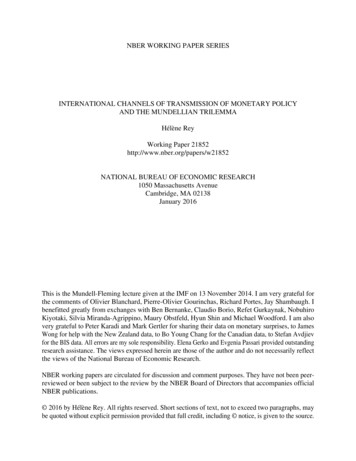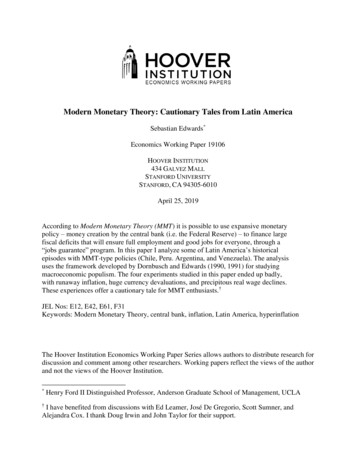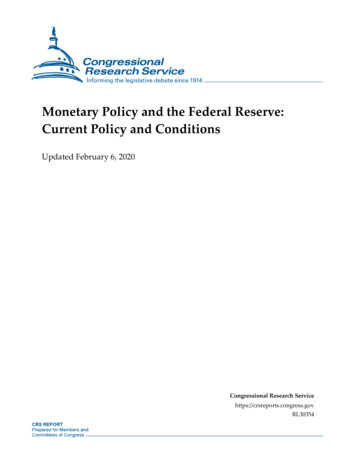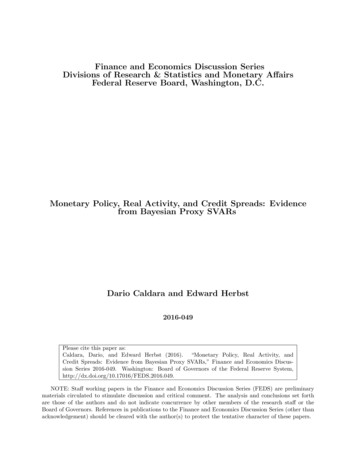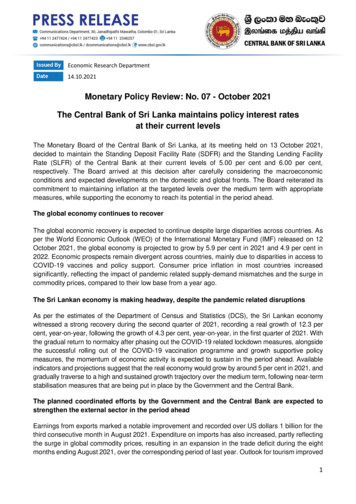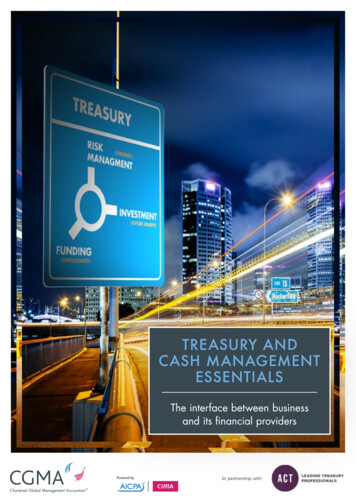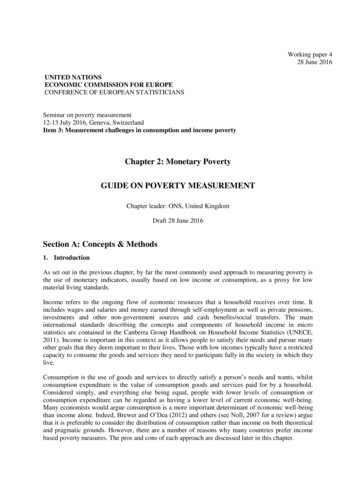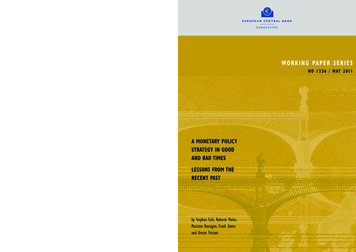
Transcription
WO R K I N G PA P E R S E R I E SN O 1 3 3 6 / M AY 2 011A MONETARY POLICYSTRATEGY IN GOODAND BAD TIMESLESSONS FROM THERECENT PASTby Stephan Fahr, Roberto Motto,Massimo Rostagno, Frank Smetsand Oreste Tristani
WO R K I N G PA P E R S E R I E SN O 1336 / M AY 2011A MONETARY POLICY STRATEGYIN GOOD AND BAD TIMESLESSONS FROM THE RECENT PAST 1by Stephan Fahr, Roberto Motto,Massimo Rostagno, Frank Smetsand Oreste Tristani 2NOTE: This Working Paper should not be reported as representingthe views of the European Central Bank (ECB).The views expressed are those of the authorsand do not necessarily reflect those of the ECB.In 2011 all ECBpublicationsfeature a motiftaken fromthe 100 banknote.This paper can be downloaded without charge from http://www.ecb.europa.eu or from the Social ScienceResearch Network electronic library at http://ssrn.com/abstract id 1814928.1 The views expressed in this paper are our own and not necessarily those of the European Central Bank or its Governing Council.We thank G. Amisano, G. Kiss, H. Pill, J. Pisani-Ferry, G. Tabellini, J. Ulbrich, J.-P. Vidal and W. Whitefor helpful comments. We gratefully acknowledge P. Gertler’s and K. Holzheu’s research assistance.2 All authors: European Central Bank, Kaiserstrasse 29, D-60311 Frankfurt am Main,Germany; e-mails: Stephan.Fahr@ecb.europa.eu; uropa.eu; pa.eu
European Central Bank, 2011AddressKaiserstrasse 2960311 Frankfurt am Main, GermanyPostal addressPostfach 16 03 1960066 Frankfurt am Main, GermanyTelephone 49 69 1344 0Internethttp://www.ecb.europa.euFax 49 69 1344 6000All rights reserved.Any reproduction, publication andreprint in the form of a differentpublication, whether printed or producedelectronically, in whole or in part, ispermitted only with the explicit writtenauthorisation of the ECB or the authors.Information on all of the papers publishedin the ECB Working Paper Series can befound on the ECB’s website, tml/index.en.htmlISSN 1725-2806 (online)
CONTENTSAbstract4Non technical summary51 Introduction72 A tale of the last 15 years2.1 The great moderation andthe financial crisis2.2 Booms and busts in assetand credit markets88103 The economy and the strategy3.1 Questions and methodology3.2 First answer: the economydid not cooperate3.3 Second answer: the strategydid steer the economy12134 The financial crisis4.1 From the financial turmoilto the Great Recession4.2 A VAR analysis245 414192530ECBWorking Paper Series No 1336May 20113
We evaluate the ECB’s monetary policy strategy against the underlying economicstructure of the euro area economy, in normal times and in times of severe financialdislocations. We show that in the years preceding the financial crisis that started in2007 the strategy was successful at ensuring macroeconomic stability and steadygrowth despite shocks to the supply side and to the transmission mechanism whichcomplicated the policy process. Emphasis on monetary indicators in the ECB’smonetary policy strategy – the monetary pillar – was instrumental in avoiding morevolatile and less predictable patterns of inflation and growth. After the collapse offinancial intermediation in late 2008, the strategy of the ECB was to preserve theintegrity of the monetary policy transmission mechanism by adopting acomprehensive package of non-standard policy measures. According to ourquantitative evaluation of the impact of the non-standard policy package, whichnotably did not include entering commitments regarding the future path of thepolicy rate, the liquidity interventions decided in October 2008 and in May 2009were critical to preserving price stability and forestalling a more disruptive collapseof the macro-economy.JEL classification codes: E31; E44; E51; E58Keywords: Monetary Policy; Monetary transmission; Credit, Supply factors; Financialcrisis; Non-standard policy measures4ECBWorking Paper Series No 1336May 2011
NON TECHNICAL SUMMARYThe outbreak of the financial turmoil in 2007 and the subsequent financial crisis with the collapse in trade andeconomic activity in 2008 have led to a rethinking of monetary policy frameworks. In this paper, we focusmainly on two aspects of this debate. First, the financial boom and bust episode of the new millennium hasquestioned the appropriateness of what is sometimes called the “Jackson Hole consensus”. According to thisconsensus central banks should only respond to asset prices and financial imbalances to the extent that theyaffect the inflation forecast. Second, the financial crisis has led to an unprecedented use of non-standardmonetary policy tools to avoid that liquidity problems turn into solvency problems with an eventual breakdownof the monetary transmission mechanism. The notion that the policy-controlled short-term interest rate is thesole tool of monetary policy has therefore been questioned.We provide evidence that the period between 1999 and 2007 was very successful for the euro area macroeconomy. Inflation was stabilised around values that had not been experienced on a sustained basis even inthose member states which had been most successful in preserving the value of their currencies in the courseof the previous decades. We show that inflation control was not purchased at the price of higher volatility inreal activity or reduced growth prospects. In fact, real per capita income growth in the euro area matched theperformance of other prominent industrialised economies which are viewed as the most dynamic from a globalperspective.But macroeconomic stability in the year leading up to the Lehman crisis masked growing underlying imbalancesin the financial sector. During the decade prior to the financial crisis, low and stable inflation and low volatilityin economic activity co-existed with highly procyclical asset price movements and pronounced cycles in moneyand credit creation. Low real and nominal volatility and falling external finance premia in those years led to asecular rise in private debt, which itself contributed to the sharpness of the correction in the most recentrecession.The boom-bust cycle that resulted from this association between the macroeconomic and the financial side ofthe economy has challenged the prescription – which is central to the most extreme characterisation of theJackson Hole consensus – that central banks should only react to asset prices and financial imbalances to theextent that they affect the short-term inflation forecast. Using the fully-specified structural model of Christiano,Motto and Rostagno (2010), we investigate this proposition. We first show that both supply side and financialshocks have been important drivers of business cycle and asset price fluctuations in the euro area. The formerproduced a de-synchronisation of inflation and real activity, which complicated the appropriate setting ofmonetary policy; the latter influenced asset price formation in directions that are atypical and seriouslyinterfered with the transmission of monetary policy. On the basis of this analysis, we then demonstrate that –against those underlying conditions – an excessive focus on short-term inflation developments can exacerbatethe boom-bust behaviour and destabilise the economy.Using counterfactual policy simulations, we argue that a forward-looking, pre-emptive strategy needs to bebalanced by safeguards which insure central bankers against policy myopia. In our policy simulations, reaction tocredit developments can represent such a safeguard. The monetary pillar of the ECB’s monetary policy strategyalerts policy to rising imbalances in the monetary sector. Monetary imbalances are well-correlated with financialimbalances. In turn, financial imbalances are typically a distinct feature of the macro-economy at those criticaltime junctures, when the central bank is called upon to draw its balancing line between short-term risks and itslong-term stability objective. In the formulation of those difficult balancing acts, monetary analysis can promotea longer-term perspective which can help overcome policy myopia.In the last section of the paper, we analyse the financial crisis and the ECB’s response to it. The measurescollectively referred to as the “Enhanced Credit Support” were activated to overcome those financial marketimpairments which were restraining credit creation and the transmission of the policy easing being pursuedthrough interest rate reductions to the broader economy. We put these measures in the context of theECBWorking Paper Series No 1336May 20115
academic literature and conduct a preliminary assessment of their effectiveness. We find that the ECBintervention was important to avoid disorderly de-leveraging in the banking sector and instrumental insustaining credit creation and averting downside risks to price stability. Our results are also consistent with thehypothesis that the non-standard measures introduced by the ECB – which, notably, do not include enteringcommitments regarding the future path of the policy rate – contributed to providing support to the euro areaeconomy. An important lesson from the financial crisis experience is therefore that by taking on a financialintermediation role in markets that are impaired, central banks can complement their more traditional interestrate policy and ensure its proper transmission. These non-standard policies are different from policies ofquantitative easing which typically aim at substituting for the traditional interest rate policy in an environmentwhere the latter is constrained by the lower bound.6ECBWorking Paper Series No 1336May 2011
1.IntroductionThe outbreak of the financial turmoil in 2007 and the subsequent financial crisis and collapse in trade andeconomic activity in 2008 following the default of Lehman Brothers have led to a rethinking of monetary policyframeworks. Recent contributions to this debate are Bean et al (2010) and Mishkin (2010).In this paper, we focus mainly on two aspects of this debate with reference to the euro area and US experienceover the last fifteen years. First, the financial boom and bust episode of the new millennium has questioned theappropriateness of what is sometimes called the “Jackson Hole consensus”. According to this consensus centralbanks should only respond to asset prices and financial imbalances to the extent that they affect the inflationforecast.2 Other observers, amongst whom White (2006) and Rajan (2005), had warned that price stability maynot be sufficient for financial stability and suggested that central banks should lean against the emergence offinancial imbalances by tightening the monetary policy stance.The European Central Bank (ECB)’s monetary policy strategy with its medium-term orientation and emphasison monetary and credit analysis explicitly allows for looking beyond the short-term price developments andtaking into account the medium-term implications of booming asset prices and credit markets for pricestability.3 As argued by Trichet (2009), excessive money and credit growth in 2004 and 2005 was an importantfactor in not reducing the main refinancing rate below 2 percent in 2004 and underpinned the need to start anormalisation process from low interest rates in 2005. In Section 3 of this paper, we examine some of thesources of the boom and bust episodes in the euro area and argue that in line with the ECB’s monetary policystrategy responding to money and credit developments helps stabilising both inflation and output. We,therefore, argue that an enhanced role of money and credit in monetary policy strategies is one of theimportant lessons from the crisis.4Second, the great recession has led to an unprecedented use of non-standard monetary policy tools for tworeasons. First, central banks had to intervene in financial markets to avoid that liquidity problems turned intosolvency problems with an eventual breakdown of the monetary transmission mechanism. Malfunctioninginterbank and other financial markets called upon central banks to take on a more active financialintermediation role. They also highlighted the fact that there was no longer a single market rate due to thecollapse of normal arbitrage activities. Second, because monetary policy had to be eased beyond what ispossible by reducing short-term interest rates close to their lower bound at zero, a number of central bankshad to pursue alternative policies of quantitative and credit easing. The notion that the policy-controlled shortterm interest rate is the sole tool of monetary policy has therefore been questioned.The ECB’s broad and flexible operational framework with a large number of counterparties and a broad set ofcollateral allowed for a quick and pervasive expansion of its intermediation role in the interbank market, whichwas first demonstrated when tensions arose on 9 August 2007.5 In Section 4, we discuss and evaluate some ofthe non-standard policy measures the ECB has taken to address the malfunctioning in financial markets. Wediscuss these measures in the context of the academic literature and conduct a preliminary assessment of theireffectiveness. We find that the ECB intervention was important to avoid disorderly de-leveraging in the bankingsector and instrumental in sustaining credit creation and averting downside risks to price stability. Our results2See, for example, Bernanke and Gertler (1995) and the response by Cecchetti et al (2000).3See, for example, Trichet (2004) and Issing (2002).4Another important lesson of the crisis that we do not examine is the need for a new macroprudential policyframework.5See Cassola, Durré and Holthausen (2010) for a thorough review.ECBWorking Paper Series No 1336May 20117
are also consistent with the hypothesis that the non-standard measures introduced by the ECB – which,notably, do not include entering commitments regarding the future path of policy – contributed to providingsupport to the euro area economy.Before addressing those two issues in the rest of this paper, we first review in Section 2 the euro areaexperience of the last fifteen years in terms of nominal, real and financial stability. This provides the backgroundand illustrates the ‘facts’ we try to explain in the paper. For comparison, we contrast the euro area evidencewith that in the United States. We show that during the decade prior to the financial crisis low and stableinflation and low volatility in economic activity have co-existed with highly procyclical asset prices. In the late1990s this took mostly the form of rising stock prices, buoyant investment and rising credit, whereas in themiddle of the last decade rising house prices and mortgage debt with falling external finance premia were themain features. The secular rise in private debt associated with the low real and nominal volatility and the fallingexternal finance premia contributed to the sharpness of the correction in the most recent recession. Animportant feature of the euro area experience is that medium and long-term inflation expectations have beenstrongly anchored throughout the last fifteen years including the period of the financial crisis. This hascontributed to limit the consequences of adverse shocks.2.A tale of the last 15 yearsIn this section, we briefly review the developments in inflation, economic activity and financial markets over thepast fifteen years in the euro area and the US. In Section 2.1 we first document how, following a period of greatmoderation, the financial crisis has affected the level and the volatility of inflation and economic activity. Thenext subsection (2.2.) then describes the underlying behaviour of financial markets.62.1The great moderation and the financial crisisThe Treaty creating the monetary union establishes price stability as the primary objective of monetary policyin the euro area. To provide a clear yardstick against which the public can hold the European Central Bank(ECB) accountable and with a view to anchoring medium- to long-term inflation expectations, the GoverningCouncil of the ECB adopted a quantitative definition of price stability in 1998. This definition reads: ‘Pricestability shall be defined as a year-on-year increase in the Harmonised Index of Consumer Prices (HICP) for theeuro area of below 2%. Price stability is to be maintained over the medium term.’ Following a thoroughevaluation of the monetary policy strategy in 2003, the Governing Council clarified that it aims to keep HICPinflation ‘below, but close to, 2%’.7Figure 2.1 plots HICP inflation over the past 15 years, as well as various survey- and market-based measures ofmedium-term inflation expectations. The average annual inflation rate in the euro area between January 1999and September 2010 has been 1.97%, about 0.65% lower than average inflation in the same 16 countries of thecurrent euro area in the pre-EMU decade. More importantly, medium-term inflation expectations as measuredby Consensus Economics or the ECB’s Survey of Professional Forecasters have consistently been very close to1.9%. Moreover, as shown in Smets (2010) and Orphanides (2010), differences across forecasters as, forexample, captured by the standard deviation, have systematically narrowed since the start of EMU up until theoutbreak of the crisis.86The review in Section 2 is very selective. One of the important developments over this period that we do not focus onis the process of real and financial globalisation.7One of the reasons for keeping inflation close to 2 percent was to allow for a buffer in the presence of the lower boundon nominal interest rates. See Section 3 for a detailed analysis of the ECB’s monetary policy strategy.ECBWorking Paper Series No 1336May 2011
This stability of inflation expectations can also be observed in other major economies. For example, Figure 2.2compares the 5-year ahead spot and 5-year forward, 5-year ahead break-even inflation rates (BEIRs), asmeasured by the difference between nominal and indexed bond yields for the euro area and the United States.The euro area in this respect compares well with the experience in the United States.8With the exception of the most recent period in which inflation briefly reached 4 percent in 2008 andsubsequent negative rates in 2009 due to highly volatile energy and commodity prices, annual inflation hasfluctuated around 2 percent in a relatively narrow band. Figure 2.3 shows that the volatility of headline inflationin the EMU period has fallen significantly compared to the pre-EMU period. This occurred because of a strongstabilisation of core inflation9 and in spite of the surge in energy inflation volatility. An additional factorcontributing to low inflation volatility is the negative correlation between core and energy inflation observed inthe euro area. This negative correlation absorbed some of the increased volatility of energy inflation and is aspecial feature of the euro area data in the post-EMU period. The ECB’s clear focus on headline inflation mayhave contributed to the negative correlation as potential cost-push factors are offset through anchored inflationexpectations.Figure 2.4 shows the evolution of the variance of headline inflation over time in 36-month moving windows andits decomposition. It reveals the sharply increased volatility of inflation rates during the most recent crisisepisode. This is, however, mainly due to the sharp rise in the volatility in energy and food price inflation.The stabilisation of headline inflation at low levels in the euro area has not been at the expense of a reducedgrowth performance.10 As shown in Figure 2.5, the average annual growth in real per capita incomes in theEMU period was 1.1 percent, compared with 1.2 percent for the United States. Output per capita for the euroarea and the US is about 11% higher than in the first quarter of 1999, although the growth dynamics betweenthe two regions differed over time. The US took a stronger hit after the burst of the dot-com bubble, butperformed especially well in 2004-2005 when the euro area suffered from subdued growth performance. Thisstrong growth performance compared to the euro area was mainly due to large differences in TFPdevelopments in the years 2002 to 2004 as documented in Figure 2.6. Section 3 further elaborates on theconsequences of supply shocks for the economy and particularly for inflation and monetary policy. Remarkably,both regions went through a similar contraction of about 5% on an annual basis during the acute period of thefinancial crisis, demonstrating in an impressive way its global implications, which is evidenced in the tradecollapse towards the end of 2008 and beginning of 2009.Figure 2.7, adapted from Benati and Goodhart (2010), shows how the financial crisis has put a (temporary) endto the long period of low nominal and real economic volatility in industrial countries. The period before thefinancial crisis, known as the great moderation, was the result of a number of factors that can be combined intothree groups: a) structural change, e.g. better inventory management (McConnel and Perez-Quiros, 2000) orfinancial innovation and better risk sharing (Blanchard and Simon, 2001), b) improved macro-economic policies,such as the establishment of stability-oriented monetary policies, and c) good luck, i.e. the absence of large8The stability of inflation expectations has also been documented using more rigorous econometric techniques inBeechey et al (2010) and Ehrmann et al (2009). Galati et al (2010) investigates whether the financial crisis has affectedthe stability of inflation expectations.9Core inflation is defined here for comparability reasons as headline inflation excluding processed and unprocessed foodand energy prices.10The EU treaty on monetary union indicates price stability as primary objective, but in addition states that ‘[w]ithoutprejudice to the objective of price stability, it shall support the general economic policies in the Community’ [LisbonTreaty 127(1)]. These general economic policies have as its task ‘to promote throughout the community a harmoniousdevelopment of economic activities, a continuous and balanced expansion, an increase in stability, an accelerated raisingof the standard of living [ ]’ [Article 119(1)]. The ECB is able to contribute to these objectives through its pursuit ofprice stability.ECBWorking Paper Series No 1336May 20119
shocks such as the oil price crises of 1974 and 1979.11 The relative importance of these factors has been hotlydebated, but all three factors are likely to have contributed to a reduction of volatility.12A number of additional observations are worth making. First, there is no apparent clear trade-off betweenoutput and inflation volatility in the cross-section of industrial countries shown in Figure 2.7. This may be partlydue to the fact that the shocks have been different across countries. Nevertheless, both output and inflationvolatility have been relatively small in the euro area compared to other countries. However, to the extent thatthe stability-oriented monetary policy of the ECB has been successful in anchoring inflation expectations andavoiding inflation or deflation scares, it may also have supported an inward shift of the output/inflation volatilitytrade-off. Smets (2010) illustrates this mechanism by performing a counterfactual simulation of the recentrecession using the ECB’s New Area Wide Model. This simulation shows that a higher sensitivity of long-terminflation expectations to actual headline inflation would have deepened the most recent recession significantlyand led to a longer period of deflation, in particular in the light of the lower bound on interest rates.Notwithstanding the differences in policy objectives and the role played by inflation expectations anddifferences in labour market institutions the trade-off between inflation and the unemployment gap, the socalled Phillips curve, appears to be very similar over the past 15 years in the euro area and the United States(see Figure 2.8). It appears that different features of labour market institutions and price-setting compensateeach other to deliver a similar sacrifice ratio. However, the range of inflation and unemployment gap outcomesis smaller in the euro area than in the US. The figure also reflects the fact that the flattening of the Phillipscurve may have been a temporary phenomenon of the last years of the great moderation.Second, there has been a uniform outward shift in the volatility of output and inflation following the financialcrisis. In the euro area this shift in inflation volatility has generally been lower than that of output compared toother countries. A closer look at the dynamic evolution of inflation and output growth volatility is presented inFigure 2.9 by employing a 5-year window for computing volatilities from 1995 until the present. The chartindicates that the turn of the century led in the euro area and the US to an increase in output growth volatility,associated with the burst of the dot-com bubble in 2001, but inflation volatility remained constant. If anything,inflation volatility slightly declined for the euro area, whereas it increased somewhat for the United States. The1999-2003 window marks the first period entirely under the auspices of the ECB. Thereafter and up until 2007inflation volatility and output growth volatility declined. The traditional stabilisation trade-off became a “tradein” for the euro area. In the United States output volatility was reduced as well, but inflation volatility remainedat its previous levels. Most recently, with the inception of the strong rise in energy prices in 2007 and 2008,volatilities in both areas increased, first for inflation, and later for output growth with the financial crisis.In conclusion, while the volatility of headline inflation and economic activity has increased quite dramaticallyover the past three years, average headline inflation and medium-term inflation expectations have remainedclosely anchored to the ECB’s definition of price stability. This in turn has contributed to stabilising bothnominal and real volatility. The low macro-economic volatility during most of the early part of the newmillennium may have contributed to a reduction in the perception of risk and an increase of leverage and debt,which subsequently exacerbated the depth of the financial crisis. In the next section, we turn to some of thedevelopments in financial markets.2.2Booms and busts in asset and credit marketsThe previous section described how the last fifteen years has been characterised by price stability. Over thesame period, signs of instability existed within the financial sector which eventually led to the most recent1011See Bernanke (2004) for an overview of the factors behind the great moderation from a policy perspective. The breakin volatility in real GDP was first documented by McConnell and Perez-Quiros (2000).12See, for example, Stock and Watson (2004).ECBWorking Paper Series No 1336May 2011
crisis. Figure 2.10 shows the development of aggregate asset prices normalised to nominal GDP in the euroarea and the US since 1995.13 This measure of aggregate asset prices includes stock market prices as well asresidential and commercial property prices weighted by their relative sectoral size.14 It vividly captures the twoboom-bust episodes in this period. The developments of aggregate asset prices in the US and the euro area areamazingly synchronised, with the euro area exhibiting slightly lower amplitude due to the relatively lower shareof stock prices in the index.The two boom and bust phases that the US and the euro area experienced over the past fifteen years haveclearly been different in nature with different implications for the rest of the economy. Figure 2.11 directlycompares the two phases through the lens of corporate bond spreads, separated into financial and non-financialcorporations. These spreads indicate the special nature of the recent crisis in comparison to the burst of thedot-com bubble in 2001. Spreads between BBB rated securities of non-financial corporations and AAAgovernment bonds in the euro area increased persistently to above 200bps during the burst of the dot-combubble, whereas financial securities remained well contained.15 During the financial crisis, instead, BBB ratedfinancial spreads have reached up to 2700 basis points over AAA rated government bond yields, whereas nonfinancial spreads have a pattern reflecting a deeper than usual recession.There are however many similarities between the two boom periods. As shown in Figure 2.12 for the euroarea, in both boom periods the rise in stock prices was associated with increasing shares of credit andinvestment in GDP in the corporate sector and supported by a fall in the external finance premium. Thereverse pattern is visible when stock prices fall, illustrating the pro-cyclicality of the financial system. The lattereffect is in line with models where collateral valuations are relevant for credit supply such as in the financialaccelerator models of Bernanke, Gertler, Gilchrist (1999) or Christiano, Motto, Rostagno (2010). Higher stockprices increase the net worth of borrowers and thereby relax the external finance constraint.Another complementary interpretation is that higher stock prices and a booming economy increase the risktaking capacity of the financial sector and thereby lead to lower risk premia, in turn reinforcing the economicboom. This process then goes in reverse when first signs of a slowing economy become apparent. Recentresearch has emphasised the importance of such a risk-taking channel as a driver of the business cycle. Forexample, Adrian and Shin (2010) argue that value-at-risk (VaR) constraints on the banking sector will lead to aprocyclical pricing of risk. Recent evidence on the impact of the monet
2007 the strategy was successful at ensuring macroeconomic stability and steady growth despite shocks to the supply side and to the transmission mechanism which complicated the policy process. Emphasis on monetary indicators in the ECB's monetary policy strategy - the monetary pillar - was instrumental in avoiding more
